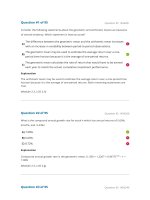Economic growth and economic development 700
Bạn đang xem bản rút gọn của tài liệu. Xem và tải ngay bản đầy đủ của tài liệu tại đây (107.28 KB, 1 trang )
Introduction to Modern Economic Growth
effect on NH /NL . Since with σ > 1 greater values of NH /NL tend to increase the
relative price of factor H compared to L, this tends to make the strong bias result
easier.
Returning to our discussion of the implications of the strong bias results for the
behavior of the skill premium in the U.S. market, Proposition 15.9 implies that values
of the elasticity of substitution between skilled and unskilled labor significantly less
than 2 may be sufficient to generate strong equilibrium bias. How much lower than
2 the elasticity of substitution can be depends on the parameter δ. Unfortunately,
this parameter is not easy to measure in practice, even though existing evidence
suggests that there is some amount of state dependence in the R&D technologies.
For example, this is confirmed by the empirical finding that most patents developed
in a particular industry build upon and cite previous patents in the same industry.
15.5. Directed Technological Change without Scale Effects
We will now see that the market size effect and its implications for the direction
of technological change are independent of whether or not there are scale effects. The
market size effect here refers to the relative market sizes of the users of two different
types of technologies, not necessarily to the scale of the entire economy, whereas
the scale effect concerns the impact of the size of the population on the equilibrium
growth rate. The results in this section show that it is possible to entirely separate
the market size effect responsible for the weak and strong endogenous bias results
and the scale effect.
Suppose that we are in the case with knowledge-based R&D model of the previous section, but only with limited spillovers from past research. In particular,
suppose that equation (15.32) is modified to
(15.41)
N˙ L = η L NLλ SL and N˙ L = η H NHλ SH ,
where λ ∈ (0, 1]. In the case where λ = 1, we have the knowledge-based R&D
formulation of the previous section, but with no state dependence. When λ < 1, the
extent of spillovers from past research are limited, and this economy will not have
steady growth in the absence of population growth.
686



